Small RNAs as guardians of the genome
- PMID: 19239887
- PMCID: PMC2792755
- DOI: 10.1016/j.cell.2009.01.045
Small RNAs as guardians of the genome
Abstract
Transposons populate the landscape of all eukaryotic genomes. Often considered purely genomic parasites, transposons can also benefit their hosts, playing roles in gene regulation and in genome organization and evolution. Peaceful coexistence with mobile elements depends upon adaptive control mechanisms, since unchecked transposon activity can impact long-term fitness and acutely reduce the fertility of progeny. Here, we review the conserved roles played by small RNAs in the adaptation of eukaryotes to coexist with their genomic colonists. An understanding of transposon-defense pathways has uncovered recurring themes in the mechanisms by which genomes distinguish "self" from "non-self" and selectively silence the latter.
Figures


References
-
- Agrawal A, Eastman QM, Schatz DG. Transposition mediated by RAG1 and RAG2 and its implications for the evolution of the immune system. Nature. 1998;394:744–751. - PubMed
-
- Aravin AA, Lagos-Quintana M, Yalcin A, Zavolan M, Marks D, Snyder B, Gaasterland T, Meyer J, Tuschl T. The small RNA profile during Drosophila melanogaster development. Dev. Cell. 2003;5:337–350. - PubMed
-
- Aravin A, Gaidatzis D, Pfeffer S, Lagos-Quintana M, Landgraf P, Iovino N, Morris P, Brownstein MJ, Kuramochi-Miyagawa S, Nakano T, et al. A novel class of small RNAs bind to MILI protein in mouse testes. Nature. 2006;442:203–207. - PubMed
-
- Aravin AA, Sachidanandam R, Girard A, Fejes-Toth K, Hannon GJ. Developmentally regulated piRNA clusters implicate MILI in transposon control. Science. 2007;316:744–747. - PubMed
Publication types
MeSH terms
Substances
Grants and funding
LinkOut - more resources
Full Text Sources
Other Literature Sources

